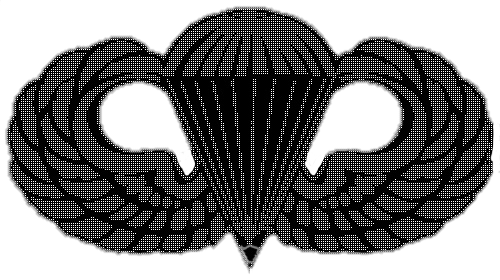The Squad Leader
We have talked a long time now and have covered only two job positions at the company. In this post we finish the rest of the major duty positions in the patrol and really the bulk of folks who actually accomplish the mission. We start with the best job in the whole Army: squad leader (SL from here on... be sure to continue to check out the acronym and abbreviations page when you see something unfamiliar).

If you remember when we introduced the PL it was said that this is my favorite job description, "what the squad does or fails to do" is just another riff on that. I should not take more opportunity to bore you with my fanaticism on ownership but I will just again say that this is the mindset you must have as a tactical leader. You own everything in this team. The people, the equipment, the mission, all are owned by the various leaders in this patrol. And it isn't the fun kind of ownership all the time, much of if means you own it but you must maintain and care for it like a servant. But I digress from the point. A SL is a leader, and also a worker in this drama. They provide much of their leadership by being the example. The best leaders I had in the military, at their peak of leadership capabilities, in their most arduous circumstances, were men in the SL position. My first good one inspired me to say that it was my overall goal of military service to one day be a SL, a goal I gratefully was able to accomplish.
We have covered maintenance of weapons and equipment before so explanation isn't really necessary, but again we should note that it is up to the SL to make sure this happens when and how it should be done. Status reports are next and it should be said that this is a lot of what a SL does to make his bread. The engine that is a patrol is a constant diagnostics check on the members and the equipment and the SLs that make up the patrol are constantly checking these gauges and telling the PL and PSG the things they need to know about resources and capabilities.
Squad Leader Actions
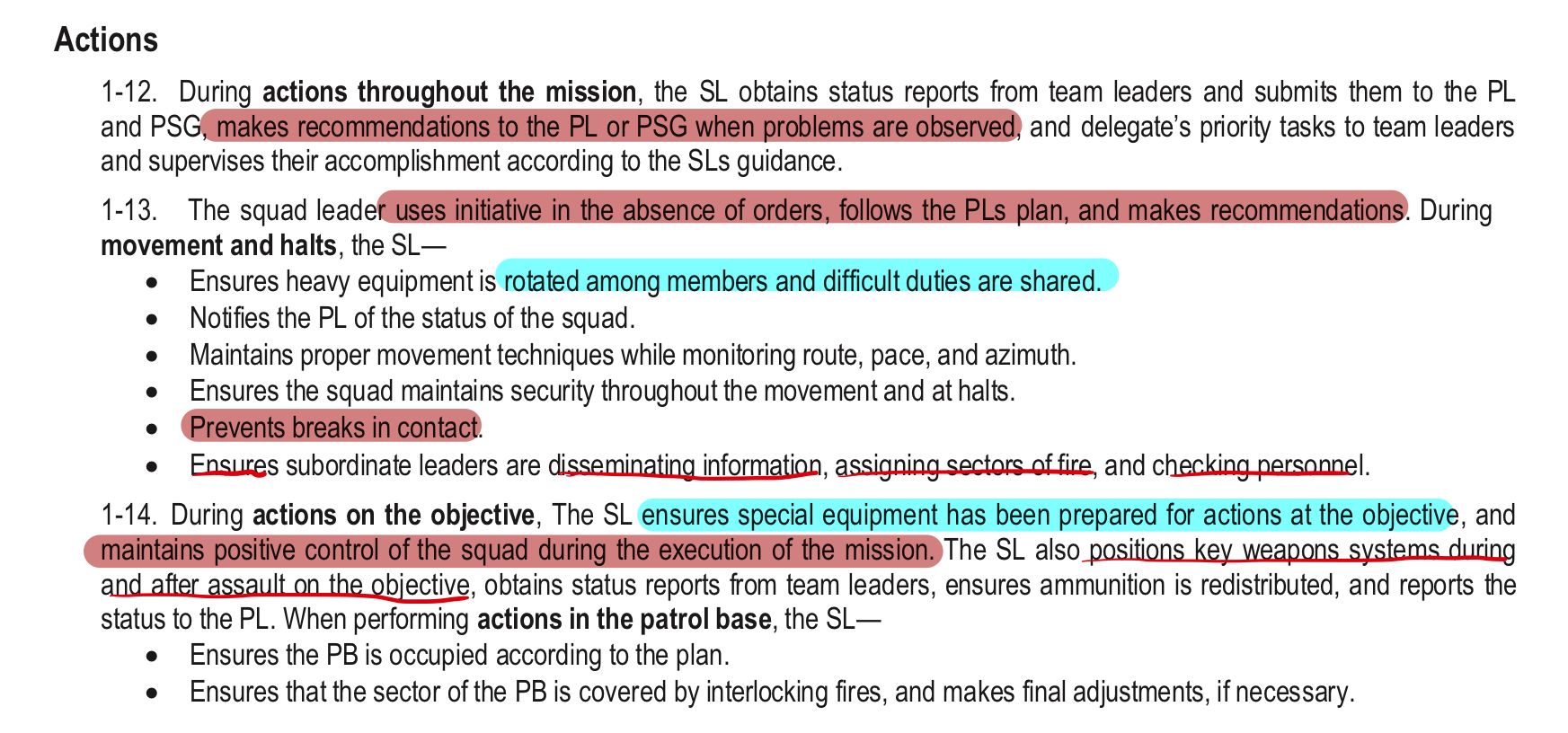

"Reports reports reports," is the march of the SL. You were warned. Now an interesting thing happens after that is reiterated. You see a person on this patrol who is not necessarily in charge but is paid to think about problems. It's actually in the job description of the SL to think about solutions to problems. Notice it doesn't say the job is to find problems. A concept we are going to start to hammer soon is a mantra that can be applied to a lot of things in business and war, "Fight the enemy, not the plan."
You see delegation mentioned again. This time it is to subordinate leadership (each SL has two Team Leaders). This shouldn't be too surprising to see applied again. The SL is again encouraged to think and apply initiative, this time saying that the position requires that a person imagines what the PL wants, and orders the squad according to the plan when the PL isn't there to issue direct orders.
The rotation of heavy equipment and sharing of dangerous or tiresome duty is also again mentioned. If you are paying attention and have read what we have discussed previously much of this material is redundant. That should be a good indicator of what it is like to be a leader on a patrol. We are working from the top down but you can surmise that much of the same things are done but the scope is scaled down for each subordinate role. Having these redundant tasks handled by redundant members ensures that it is accomplished and tracked by nearly everyone.
Not sure if we have talked about break in contact in too much depth beyond a mention of it in the actions of the PSG. A break in contact occurs when a patrol doesn't maintain control of its members. Usually this is due to fatigue or restrictive terrain. People get tired and don't closely track the people ahead of or behind them. They also might lose visual contact with them due to vegetation or weather. Either way the element stops functioning as a complete and whole unit.
Ensuring that Team Leaders (from here on TLs) do there jobs is best done with spot checks. Asking the Line Soldier what sectors of fire they cover, or information that was intended for dissemination is a good way to do this. You can also see if they have been well taken care of by their TL by asking how they are doing. Again there is a maternal/paternal nature thing going on here, where the SL is supplying a bit of the former and the TL is acting in the latter.
We can close out the SL by introducing the idea of the listening post/observation post LP/OP as everything else is redundant from other, previous discussions. Sometimes a unit, in order to ensure security or to provide early warning, will position Soldiers a ways out from the main body. These are not generally called LPs or OPs, at least I have never heard it described separately. People combine the term and say LP/OP together. Soldiers placed out on LP/OPs are charged with being a sensor on behalf of the rest of their comrades. They look and listen for contact with the enemy, other units, or civilians and give the patrol time to react as appropriate.
Weapons Squad Leader (The Weasel)
So take all the coolness of an SL job and throw in crew served weapons instead of a normal squads compliment of rifleman, grenadiers, automatic gunners. The Weapons Squad carries the bigger guns and provides the support by fire functions for the patrol. This is an incredibly important job and typically is held by the Soldier who has been a squad leader for some time, and is going to be on their way to being a PSG soon. After I was a SL I looked forward to becoming the Weasel (WSL). It's a bit like being the consiglieri to the PL and PSG. When you hold this billet you are usually and finally in the esteem of the whole company. You are a made man for sure.
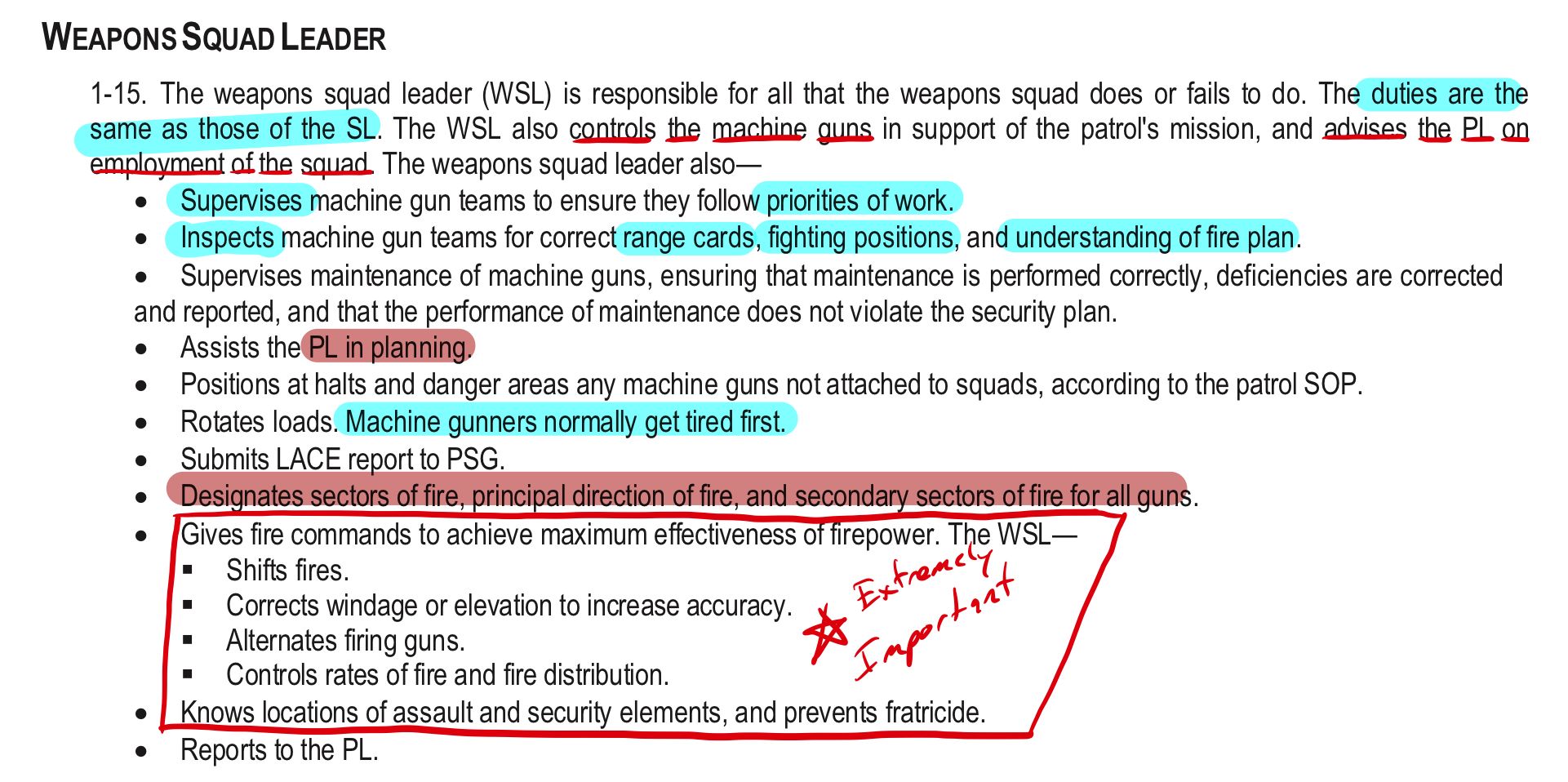
Again the WSL is just another SL, only they are in control of the heavy or crew served weapons (mostly just the large caliber machine guns assigned to the platoon/patrol). The difference is that not only does the WSL have the knowledge of a SL, they are an expert SL. And having graduated to that expertise they have taken on an extremely difficult part of the mission: supporting the line squads with suppressive or protective fires. this additional duty also has them helping the PL in the planning of missions by ensuring the Weapons Squad is used to maximum effectiveness.
Since priorities of work were covered before in the post about the PSG, we won't cover it again. But if you recall it was heavy on the placement and maintenance of the key weapons up front, so it is important to the rest plan to make sure the WSL gets these tasks knocked out quickly, literally everyone is waiting on this so they can clean up, eat, drink, and hopefully sleep. We also have kind of beat up the concept of rotating duties, assistance to planning, and maintaining equipment.
Now there can be entire posts about the types of, gunnery, drilling, employment, and firing of machine guns, and if you are interested there is an associated FM dedicated to the art of automatic fire. It's a fun read, truly. But for our purposes now just see that the WSL is tasked with setting up the guns with principal and secondary direction of fires. As the name implies principal directions of fires are ones that are primary to the weapon's default deployment. These are generally areas that seem to be likely avenues of approach by the enemy, and have good fields of fire. Secondaries would again, as the name implies, be those places next best covered by these heavier weapons.
Fire commands are how a WSL goes about his deadly work. It is probably important to introduce them now. The first is vitally important and is the shift fire command. A core principle to Infantry maneuver is a principle of suppression and movement. In order to gain the latter fires are directed at the target of the approach using the former, meaning before you move onto an objective you prevent return fire and the movement of any poor bastards. The Weapon Squad specialized in these suppressive fires. Now obviously you cannot continue to fire on this objective when the movement element gains a certain proximity. When this phase line is crossed by the maneuver element it is the job of the support (read suppressive) element to shift the fire off the objective directly. As this maneuver element continues to sweep so do the fires, keeping just ahead of them. It is a very delicate operation and has to be done very carefully. Too early a shift in fire and the suppression effect allows anyone on the objective to move or fire on the maneuver element. Too late a shift in fire and the supporting element shoots at the friendly maneuver element.
Running a machine gun is not easy. A Gunner and an AG (Assistant Gunner) are tasked with firing and feeding the gun each, respectively. Each are also trying their best to make those fires effective, but the WSL, being off the gun and keeping an eye on friendly forces, enemy forces, and fires is a little better at judging the effects, therefore should be making additional corrections for windage and elevation.
Alternating the fires is generally referred to by those practicing the trade as "talking the guns." This means to ensure that guns are not running at the same time, or worse, both going silent. Usually a Weapons Squad has two crew served machine guns and the WSL is going to control the rate of fire as well as the length of burst and trading of fire. One gun is shooting at all times when engaged, and when a barrel must be changed the other gun picks up on longer or more frequent bursts. This all sounds really easy but it isn't. There is only so much ammunition and the pacing of the maneuver element, the number of enemies present, and issues with weapons going down (read: having malfunctions or issues maintaining fire) can effect how well this is done. A good WSL knows how much ammo is available, how fast it is going out the barrels, and is constantly working the Weapon Squad teams to keep firing. All of this is done within the din of the most terrific form of noise made by mankind. A good WSL can keep the objective suppressed and saturated with accurate and high volume fire up until the last safe moment. The WSL has possibly the most important duty on many objectives, and certainly the job with the highest possibility of fratricide.
The Team Leader
It is said the the NCO Corp is the backbone of the Army, and if this is so then the Team Leader (TL) is the tailbone. This is said only a bit in jest, as the spine cannot stand without its base. The TL is the base of the Army. This series has already given you a dozen metaphors for mommy and daddy so let's say your TL is your big brother who can beat you up, and everyone blames him when you are screwed up. He has all the pressure in the world on him to make sure the troops under his control are squared away. This is a tough a job.

Being the lowest level leader in this unit, much of the interface between Soldiers and the previously described duty positions happens only according to the performance of the TLs. Fires again are important to the line squads just like the Weapons Squad, but they have the additional burden of controlling movement that support by fire functions don't typically have to deal with as much. As you might imagine controlling where men go and where they shoot can be extremely difficult, but it is especially difficult when these events are affecting you too. But that is the work of a TL. It is vitally important that the TL does this from the front, for what should be obvious reasons by now. The last sentence again is one of the most widely worded and vague job descriptions ever written. Essentially and again, the TL is just responsible, for everything and everyone on the team.
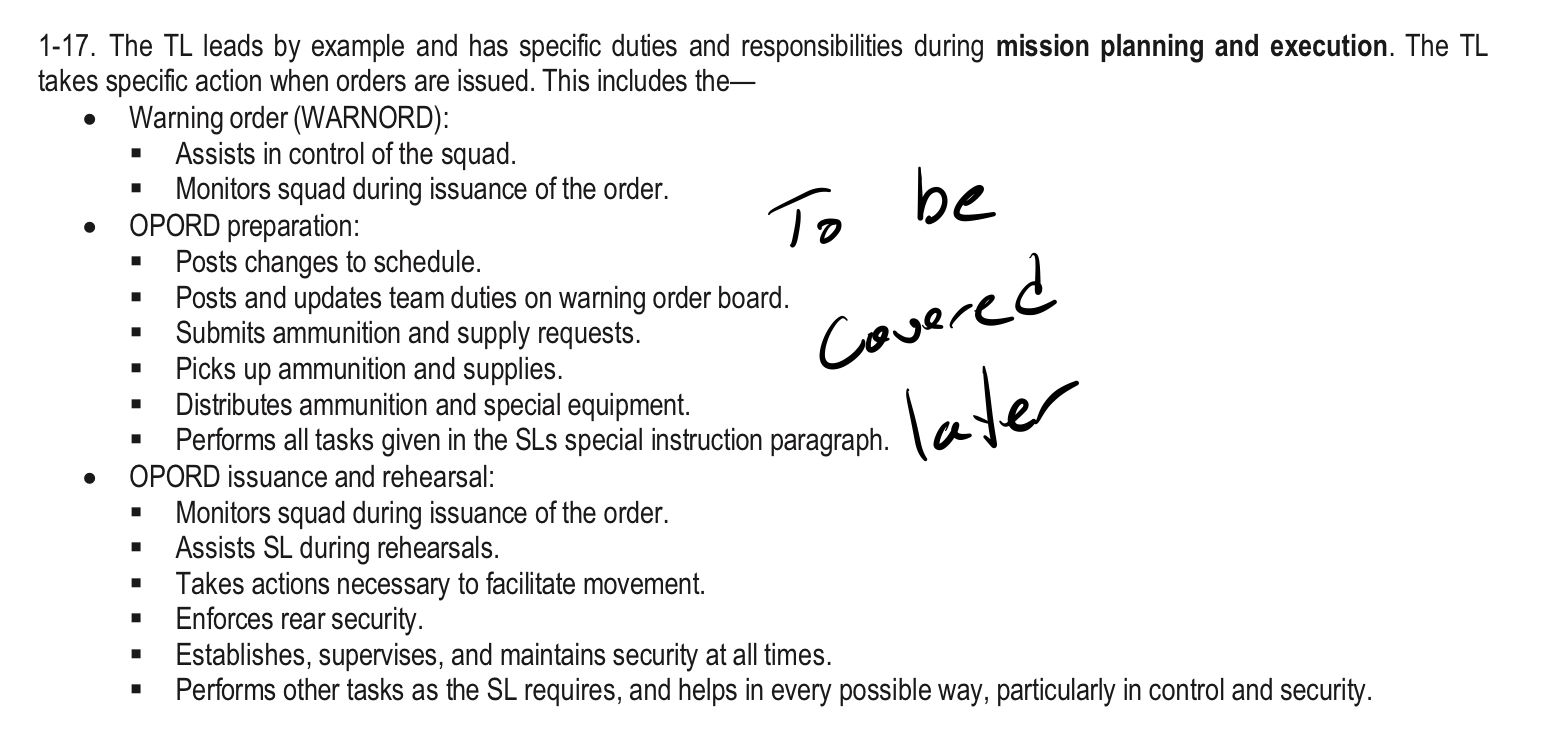
We have yet to punt on something in our walkthrough of the Ranger Handbook, but we are about to do it now. There is an upcoming and arduous discussion of both the Warning and Operations Order. For the purposes of our discussion now just read this excerpt and know that the TLs are little Stasi watching every member of their team during the issuance of these orders. They are also busy as killer bees getting the logistics and rehearsals conducted on time during these initial mission planning and later mission fine tuning efforts. God help you if you are not paying attention or putting your ass into getting ready and your TL catches you. Stay tuned for more on the WARNORD and OPORD. It will happen sooner than you think and you'll wish we were talking about something fun.

We talked a little bit about the objective rally point (ORP) when we discussed the PL, and when we covered the PSG. It was a brief mention for the PL and the metaphor used for the PSG was that the ORP is where people put on their makeup and dancing shoes before the ball. This list of duties for the TLs should greater illuminate that metaphor for us. Security anywhere is a duty for everyone, but as TLs are our interface between leadership and the members of the patrol they are explicitly responsible for it. That "final preparation of Rangers, weapons, and equipment" part is the dancing shoes and makeup. Everything needs to be on fleek because the actions on the objective (shortly to be described some) will require it. This is our last chance to get ready before nearly certain contact, things have to be squared away.
Because people will be coming and going to complete the preparation for this upcoming conflict, the perimeter will be shifting constantly. The TLs are going to maintain this perimeter by making sure that strength is distributed consistently and or where appropriate throughout the time in the ORP. After reconnaissance is performed certain information about the objective and mission can be filled in, this is usually referred to as priority intelligence requirements. It is the job of the TLs to disseminate it to the frontline troops.

Special equipment is kind of a catch all term used to describe items that are not typically used in a patrol. Something like a breaching tool, camera, or demolition charge would be special equipment. Usually as a part of the plan a team will know that while on the objective they are tasked with a specific job, and often it involves special equipment. They are therefore responsible for ensuring this equipment is ready and prepped for action.
Again the TLs are going to be responsible for moving and directing the fires of his team. We will soon discuss the principles of fire and maneuver in more detail, but this is a delicate operation, especially when you involve multiple teams and squads. It's important that the TLs know where their Soldiers are to prevent fratricide or breaks in contact.
We need to note that while this paragraph begins talking about actions on the objective, the bullets below are not about actions on the objective, they are about what TLs do during actions of the patrol base. Nothing here should be a surprise by now as we can see that most tasks are becoming redundant. Enforcement of the priorities of work are a good job for TLs, as they should be watching and communicating with their teams continuously.
The Medic "Doc"

One of the most cherished member of any platoon is the medic, for obvious reasons. Often called "Doc" by the unit members this person is tasked with what you might expect from someone who has to care for the health of Infantrymen. Aid and litter teams obviously are going to be his purview, same as health and hygiene. Treating the casualties is a medic's specialty, as well as determining which of the wounded men can be fixed, and what order they are best attended to when time is limited.

Class VIII is just a fancy word for medical supplies. The Doc is the platoon's source for these and his source is the battalion Aid Station or a similar facility. You won't get medical supplies from anyone else and this is for good reasons. Rarely is a unit stingy with these resources but the medic is there to ensure that waste is not a problem. We discussed casualty feeder reports before when we discussed the PSG, and so that knowledge should serve as adequate explanation as to why this is a medic's job.
Radio Operator
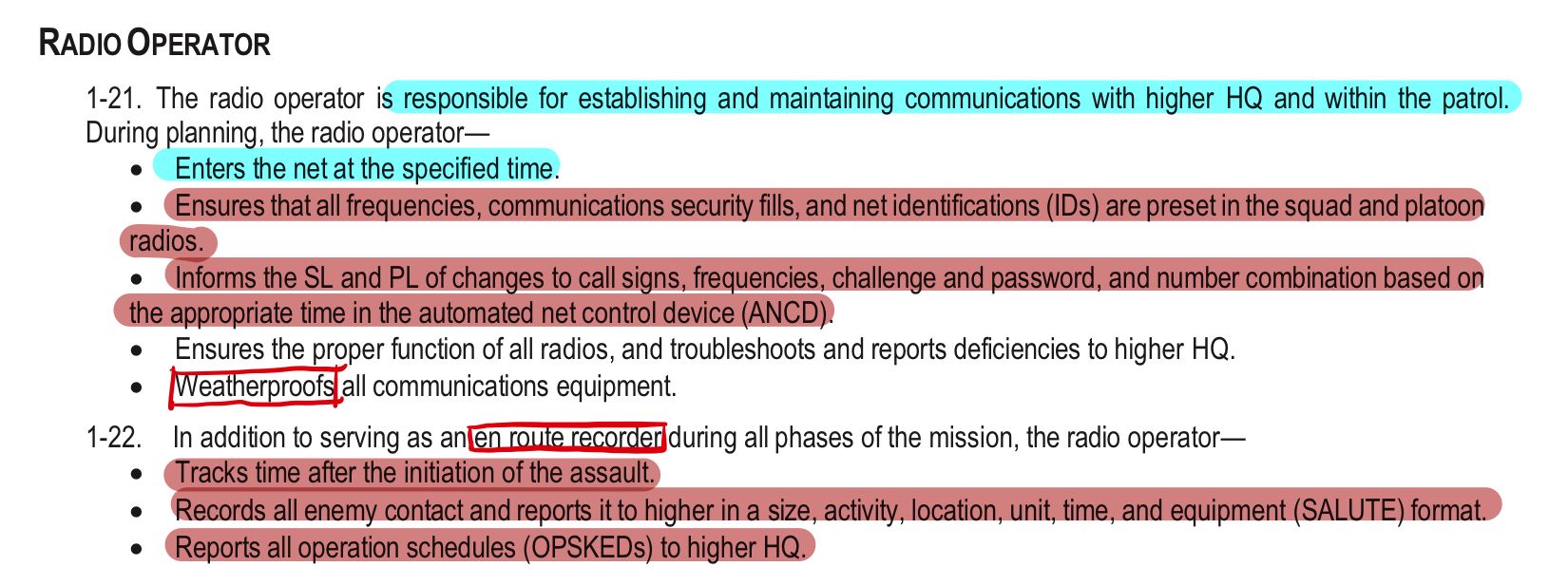
You might notice all the red used to highlight and outline items here, and it may make it appear that the Radio Operator (RTO) is an important job. That is because it in fact is an important job, maybe the most important job performed by a person who doesn't have sergeant stripes. Almost nothing can happen in a patrol without an RTO long term, because modern warfare requires constant communication. This communication is only possible when the RTO maintains contact with HQ or other members of the patrol.
We are not going to spend a lot of time talking about radios in this series, but understand that radios require a lot of effort to ensure they talk to each other. Much of this is due to the security controls that have been applied to protect the network traffic they produce. This includes the specific frequency, encryption, and callsigns they use to make sure the right people are talking, listening, and identified. Your RTO has to do all that, for all radios at all times.
Now that might seem simple enough, but understand these settings change... often. You might be in the middle of a patrol and higher headquarters will have scheduled a change to these settings. The RTO then has to change all of this in the field, using a device called an ANCD. I won't go into details but just understand this is a huge pain in the ass. A good RTO is worth his money is gold.
In addition to these duties the RTO is kind of a walking scribe and source of information for people, both within the patrol as well as across the radio to higher HQ or other units. They call this walking scribe an en route recorder. Basically the RTO at key moments will be writing down notes or keeping track of time, allowing others (most importantly the PL) an ability to focus on their important tasks. Time onsite in an ambush is vitally important because you want to get it over with to avoid counterattack. You also might want to know what items were taken off the enemy, or how many attacked you. The latter is usually communicated to HQ using a SALUTE report. We might cover that in greater detail later, but the format is rather simple and intuitive.
Forward Observer

This last duty position is like the Doc in that they are not "real" Infantrymen, but everyone treats them so while on the Line. A Forward Observer is a specialist involved in the trade of dropping indirect fire and sometimes close air support on the enemy on behalf of the patrol. Now every person on the battlefield should be able to call for fire, but this job makes it their art and complete responsibility. Skipping to the bottom lets us know how they start this work. They always know where they are, or at least should. Knowing that they can use a variety of methods to bring down steel rain on your enemies. They know the best ordinance to use against various targets, the best methods for adjusting fires, and the best ways to communicate this to the mortarmen and artillerymen (of which they are technically one). If you see troops in the open out of reach, or make contact quickly with the enemy you want them on the radio to battalion or brigade fires.
Now outside the obvious benefits while on patrol, FOs help make a plan better by making sure that while you are out there, you have the ability to call for fire. It is there job to make sure that resources are available, if possible, throughout the planned patrol, and that you can communicate with those who provide fires. The FO is very much related to, and works with, the RTO. Part of why the headquarters element of a patrol looks like an antenna farm is because the RTO and the FO are close at hand to the PL.
Assuming Command

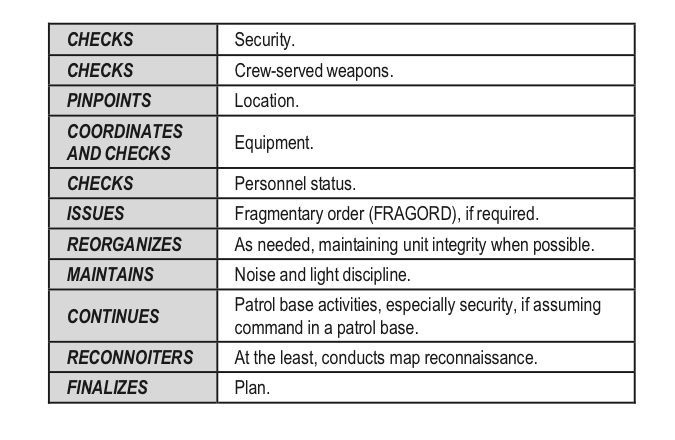
This checklist probably seems obvious, but when command is assumed in the field it is often due to some adverse action, like a fight that produced casualties in leadership. Therefore this checklist attempts to help remind an assuming leader of all the things needed to make this transition easier, safer, and better done.
End of Chapter 1!
No one reads the Ranger Handbook to learn about leadership, although there are great lessons to be learned there. We had to cover it to get to the good parts, and the reason a lot of folks cherish this pamphlet. But the good news now is we are going right into the good stuff now. Be ready to take what you have learned about the duty positions and leaders and begin to apply them to first the planning, and next the conduct of patrolling when we begin to cover our next chapter, Operations.
